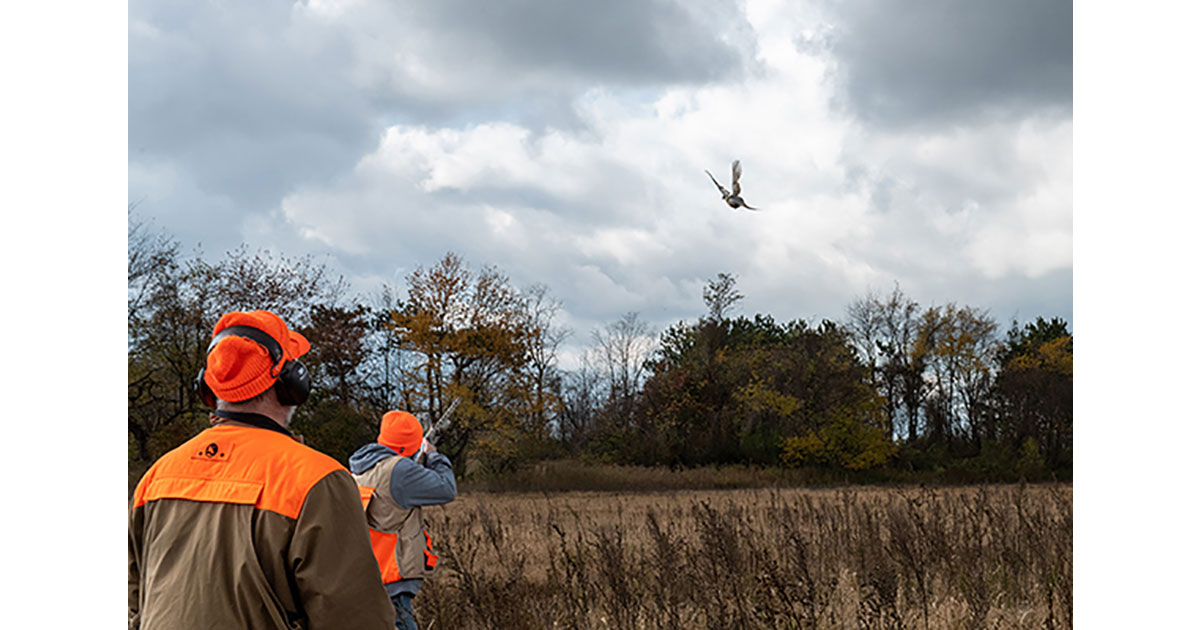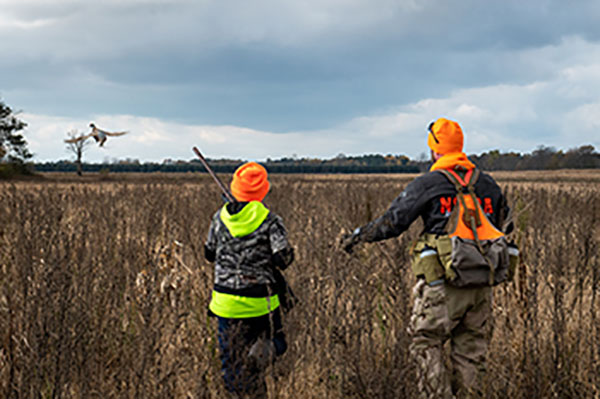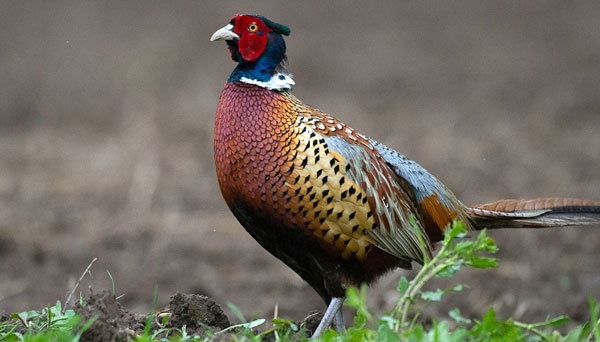- Details
By ADAM BUMP, Upland gamebird specialist
Michigan Department of Natural Resources
 Michigan Pheasant hunting
Michigan Pheasant hunting
Although many may have trouble believing it now, the opening day of ring-necked pheasant hunting was once like opening day of deer season in Michigan.
Thousands looked forward to mid-October. People planned vacation days in advance to make sure they could hit the farm fields and grasslands. Kids skipped sitting in classrooms for a chance to hear the burst of strong wings and the telltale cackle of a pheasant rooster.
Pheasant hunting was king for many hunters in Michigan’s farmlands.
There are still many active hunters, although admittedly a bit slower-moving and probably with a few gray hairs (at least), who remember the heyday of hunting wild pheasants here.
In 1944, Michigan’s pheasant harvest topped 1.4 million birds. An average of over 1 million birds were harvested each year from 1937-1959. Small game hunters during that same time numbered between 500,000 and 700,000.
Sadly, over the past seven decades, wild pheasant numbers have declined in the state.
This change was predictable, as Michigan’s agricultural landscape looks nothing like it did in the 1940s and 50s.
Back then, farm country was expansive. Few tillable acres in the southern third of the state were not actively farmed. Even some areas that were difficult or impossible to be farmed were still under the plow or under hoof and being used as pasture for cattle, sheep and other livestock.
Farms had smaller fields, with grassy or shrubby fencerows dividing those fields. Many different types of small grains were grown, rather than the modern landscape of large fields with corn, soybeans and wheat dominating Michigan’s croplands.
Farming practices were different too.
Farming practices were less efficient, and leftover grain and some wildlife cover often remained in the fields. Some farms still used fallow fields in their rotation, giving fields a rest from growing grain crops and allowing those fields to go unworked for a year or more – inadvertently providing food and nesting cover for pheasants.
As practices slowly changed, and as some fields were abandoned and eventually matured into forests, pheasant numbers declined.
In 2017, the Michigan Department of Natural Resources estimated that 12,855 pheasants were taken in the hunting season by only 16,443 pheasant hunters. A far cry from the peak in the 1940s.
The DNR has been actively managing habitat and is a primary member of the former Michigan Pheasant Restoration Initiative (now the Michigan Grassland Coalition), co-chairing the group with Pheasants Forever.
This coalition partners with agencies, nongovernmental organizations, landowners and others to promote the enhancement and creation of grasslands for the benefit of pheasants and other grassland species.
- Details
IDNR Report
Applications for the 2023 Put/Take Pheasant Hunts open Wednesday, at 7 a.m. EST.
It will continue to the end of the Put/Take Pheasant Hunt period or until hunts sell out.
The hunts take place from Nov. 18–26. Registration costs $30 per registered hunter and is first-come, first-served. Once the daily hunter quota is reached, the area becomes unavailable. Hunters should print their registration confirmation sheet and bring it with them on the day of their hunts. The bag limit is two pheasants per person each day.
The Fish & Wildlife areas (FWA) participating in the Put/Take Pheasant Hunts are Atterbury, Glendale, J.E. Roush Lake, Pigeon River, Tri-County, Willow Slough, and Winamac. To find out more information regarding the Put/Take Pheasant Hunt, please contact the property at which you are interested in hunting. For more information, register online at https://www.in.gov/dnr/fish-and-wildlife/hunting-and-trapping/reserved-hunts/#Put_and_Take_Pheasant
- Details
MDNR Report
 Pheasant Hunters
Pheasant Hunters
The Michigan DNR’s highly anticipated pheasant release program is expanding for the upcoming pheasant hunting season. This year, the program will include:
- Three times more rooster pheasants released than last year.
- Four new release sites in Cass City, Crane Pond, Dansville and Stanton state game areas.
- Additional releases in December on state game areas with an open pheasant hunting season.
This strategic expansion ensures a greater distribution of released pheasants and gives hunters even more options to explore Michigan's diverse landscapes.
“For seasoned hunters and newcomers alike, this is a prime opportunity for everyone to experience the thrill of pheasant hunting. We’re excited to expand the pheasant release program and offer hunters a unique chance to connect or reconnect with upland bird hunting in Michigan,” said Adam Bump, DNR upland game bird specialist. “The increased number of rooster pheasants and the addition of new release locations ensure that hunters can enjoy a memorable hunting season.”
The rooster-only pheasant releases will occur Oct. 20 to Nov. 14, coinciding with the pheasant hunting season. All release sites that have an open December pheasant hunting season will have an additional pheasant release in December.
This year, pheasants will be released on 13 state game/wildlife areas throughout southern Michigan:
- Cass City (Tuscola County) – fall and December release.
- Cornish (Van Buren County) – fall release only.
- Crane Pond (Cass County) – fall release only.
- Crow Island (Bay and Saginaw counties) – fall and December release.
- Dansville (Ingham County) – fall and December release.
- Erie (Monroe County) – fall and December release.
- Lapeer (Lapeer County) – fall and December release.
- Leidy Lake (St. Joseph County) – fall and December release.
- Pinconning (Bay County) – fall release only.
- Pointe Mouillee (Monroe and Wayne counties) – fall and December release.
- Rose Lake (Clinton and Shiawassee counties) – fall and December release.
- Stanton (Montcalm County) – fall and December release.
- St. Johns Marsh (St. Clair County) – fall and December release.
The sale of the $25 pheasant license funds the pheasant release program, with pheasants supplied by the Michigan Association of Gamebird Breeders and Hunting Preserves.
“We encourage people to take advantage of this remarkable opportunity to connect with nature and experience the joy of upland bird hunting,” Bump said.
To learn more about the pheasant release program, including licensing requirements, season dates and hunting regulations, visit Michigan.gov/SmallGame.
- Details
MDNR Report
There were 6,586 bear licenses and 260 elk licenses available for the 2023 fall hunting seasons. Drawing results are now in, and you can check them online at eLicense or on the Michigan DNR Hunt Fish app, or call 517-284-9453 (WILD), to learn if you were successfully drawn.
Hunters selected in the drawing can buy their license at any license agent or online. Elk hunters drawn for a license will be mailed a packet of information that will include information about the elk hunter orientation.
If you are curious how the drawing process works for bear and elk, watch our videos:
• Bear Draw Preference Point System Explained.
• Elk Weighted Lottery System Explained.
Successfully drawn but unable to hunt this fall?
Successful applicants can transfer or donate their drawing success to an eligible person they know or a person on the Department of Natural Resources hunt waiting list. Transfer forms and other information are available at Michigan.gov/HuntTransfers. The deadline to transfer a license is Sept. 1.
DNR hunt waiting list
Unsuccessful youth applicants and those with an advanced illness can register for a donated (transferred) bear or elk hunt until July 10. Register at Michigan.gov/HuntTransfers.
- Details
MDNR Report
 Pheasant
Pheasant
This year, pheasants will be released during the Oct. 20-Nov. 14 regular pheasant season on nine Michigan game areas throughout the southern part of the state.
They include:
- Cornish (Cass County).
- Crow Island (Bay and Saginaw counties).
- Erie (Monroe County).
- Lapeer (Lapeer County).
- Leidy Lake (St. Joseph County).
- Pinconning Township (Bay County).
- Pointe Mouillee (Monroe and Wayne counties).
- Rose Lake (Clinton and Shiawassee counties).
- St Johns Marsh (St. Clair County).
A base license and a public-land pheasant license are required to hunt these areas, and all regular hunting regulations apply.




